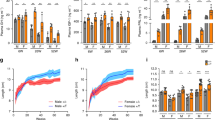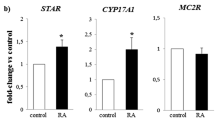Abstract
Adrenocorticotrophic hormone (ACTH)-secreting pituitary tumors are associated with high morbidity due to excess glucocorticoid production. No suitable drug therapies are currently available, and surgical excision is not invariably curative. Here we demonstrate immunoreactive expression of the nuclear hormone receptor peroxisome proliferator-activated receptor-γ (PPAR-γ) exclusively in normal ACTH-secreting human anterior pituitary cells: PPAR-γ was abundantly expressed in all of six human ACTH-secreting pituitary tumors studied. PPAR-γ activators induced G0/G1 cell-cycle arrest and apoptosis and suppressed ACTH secretion in human and murine corticotroph tumor cells. Development of murine corticotroph tumors, generated by subcutaneous injection of ACTH-secreting AtT20 cells, was prevented in four of five mice treated with the thiazolidinedione compound rosiglitazone, and ACTH and corticosterone secretion was suppressed in all treated mice. Based on these findings, thiazolidinediones may be an effective therapy for Cushing disease
This is a preview of subscription content, access via your institution
Access options
Subscribe to this journal
Receive 12 print issues and online access
$209.00 per year
only $17.42 per issue
Buy this article
- Purchase on Springer Link
- Instant access to full article PDF
Prices may be subject to local taxes which are calculated during checkout






Similar content being viewed by others
References
Issemann, I. & Green, S. Activation of a member of the steroid hormone receptor superfamily by peroxisome proliferators. Nature 347, 645–660 (1990).
Schoonjans, K., Martin, G., Staels, B. & Auwerx, J. Peroxisome proliferator-activated receptors, orphans with ligands and functions. Curr. Opin. Lipidol. 8, 159–166 (1997).
Kliewer, S.A., Umesono, K., Noonan, D.J., Heyman, R.A. & Evans, R.M. Convergence of 9-cis retinoic acid and peroxisome proliferator signaling pathways through heterodimer formation of their receptors. Nature 358, 771–774 (1992).
Palmer, C.A.N., Hsu, M.H., Griffin, K.J. & Johnson, E.F. Interaction of the peroxisome proliferator-activated receptor α with the retinoid X receptor α unmasks a cryptic peroxisome proliferator response element that overlaps an ARP-1-binding site in the CYP4A6 promoter. J. Biol. Chem. 270, 16114–16121 (1995).
Tontonoz, P., Hu, E., Graves, R.A., Budavari, A.I. & Spiegelman, B.M. mPPARγ2: Tissue-specific regulator of an adipocyte enhancer. Genes Dev. 8, 1224–1234 (1994).
Spiegelman, B.M. PPAR-γ: Adipogenic regulator and thiazolidinedione receptor. Diabetes 47, 507–514 (1998).
Kliewer, S.A. et al. A prostaglandin J2 metabolite binds peroxisome proliferator-activated receptor γ and promotes adipocyte differentiation. Cell 83, 813–819 (1995).
Forman, B.M., Tontonoz, P., Chen, J., Brun, R.P., Spiegelman, B.M. & Evans, R.M. 15-Deoxy-Δ12,14-prostaglandin J1 is a ligand for the adipocyte determination factor PPAR γ. Cell 83, 803–812 (1995).
Saltiel, A.R. & Olefsky, J.M. Thiazolidinediones in the treatment of insulin resistance and type II diabetes. Diabetes 45, 1661–1669 (1996).
Ricote, M., Li, A.C., Willson, T.M., Kelly, C.J. & Glass, C.K. The peroxisome proliferator-activated receptor-γ is a negative regulator of macrophage activation. Nature 391, 79–82 (1998).
Jiang, C., Ting, A.T. & Seed, B. PPAR-γ agonists inhibit production of monocyte inflammatory cytokines. Nature 391, 82–86 (1998).
Xin, X., Yang, S., Kowalski, J. & Gerritsen, M.E. Peroxisome proliferator-activated receptor γ ligands are potent inhibitors of angiogenesis in vitro and in vivo. J. Biol. Chem. 274, 9116–9121 (1999).
Staels, B. et al. Activation of human aortic smooth-muscle cells is inhibited by PPAR-α but not PPAR-γ activators. Nature 393, 790–793 (1998).
Elstner, E. et al. Ligands for peroxisome proliferator-activated receptor-γ and retinoic acid receptor inhibit growth and induce apoptosis of human breast cancer cells in vitro and in BNX mice. Proc. Natl. Acad. Sci. USA 95, 8806–8811 (1998).
Kubota, T. et al. Ligand for peroxisome proliferator-activated receptor-γ (troglitazone) has potent anti-tumor effects against prostate cancer both in vitro and in vivo. Cancer Res. 58, 3344–3352 (1998).
Sarraf, P. et al. Differentiation and reversal of malignant changes in colon cancer through PPAR γ. Nature Med. 4, 1046–1052 (1998).
Heaney, A.P. & Melmed, S. Molecular pathogenesis of pituitary tumors. in Oxford Textbook of Endocrinology (eds. Wass, J.A.H. & Shalet S.M.) 2, 109–120 (Oxford University Press, Oxford, 2002).
Ross, E.J. & Linch, D.C. Cushing's syndrome-killing disease: Discrimatory value of signs and symptoms aiding early diagnosis. Lancet 2, 646–649 (1982).
Oldfield, E.W. et al. Petrosal sinus sampling with and without corticotrophin-releasing hormone for the differential diagnosis of Cushing's syndrome. N. Engl. J. Med. 325, 897–905 (1991).
Shimon, I. & Melmed, S. Management of pituitary tumors. Ann. Intern. Med. 129, 472–483 (1998).
Melmed, S. et al. Consensus: Guidelines for acromegaly management. J. Clin. Endocrinol. Metab. 87, 4054–4058 (2002).
Simmons, N.E., Alden, T.D., Thorner, M.O. & Laws, E.R. Jr. Serum cortisol response to transphenoidal surgery for Cushing disease. J. Neurosurg. 95, 1–8 (2001).
Mampalam, T.J., Tyrrell, J.B. & Wilson, C.B. Transsphenoidal microsurgery for Cushing's disease: A report of 216 cases. Ann. Intern. Med. 109, 487–493 (1988).
Hoybye, C. et al. Adrenocorticotrophic hormone-producing pituitary tumors: 12 to 22-year follow-up after treatment with sterotactic radiosurgery. Neurosurgery 49, 284–291 (2001).
Findling, J.W. & Raff, H. Diagnosis and differential diagnosis of Cushing's syndrome. Endocrinol. Metab. Clin. North Am. 30, 729–477 (2001).
Orth, D.N. Cushing's syndrome. N. Engl. J. Med. 332, 791–803 (1995).
Brada, M. et al. The long-term efficacy of conservative surgery and radiotherapy in the control of pituitary adenomas. Clin. Endocrinol. 38, 571–578 (1993).
Trainer, P.J. & Besser, M. Cushing's syndrome: Therapy directed at the adrenal glands. Endocrinol. Metab. Clin. North. Am. 23, 571–584 (1994).
Krieger, D.T., Amorosa, L. & Linick, F. Cyproheptadine-induced remission of Cushing's disease. N. Engl. J. Med. 293, 893–896 (1975).
Sonino, N. The use of ketoconazole as an inhibitor of steroid production. N. Engl. J. Med. 317, 812–818 (1987).
Vale, W., Spiess, J., Rivier, C. & Rivier, J. Characterization of a 41-residue ovine hypothalamic peptide that stimulates secretion of corticotropin and β-endorphin. Science 213, 1394–1397 (1981).
White, A. & Gibson, S. ACTH precursors: Biological significance and clinical relevance. Clin. Endocrinol. 48, 251–255 (1998).
Trainer, P.J. et al. Transsphenoidal resection in Cushing's disease: Undetectable serum cortisol as the definition of successful treatment. Clin. Endocrinol. 38, 73–78 (1993).
Wakino, S., et al. Peroxisome proliferator-activated receptor γ ligands inhibit retinoblastoma phosphorylation and G1 → S transition in vascular smooth cells. J. Biol. Chem. 275, 22435–22441 (2000).
Sugimura, A. et al. Troglitazone suppresses cell growth of myeloid leukemia cell lines by induction of p21WAF1/CIP1 cyclin-dependent kinase inhibitor. Biochem. Biophys. Res. Comm. 261, 833–837 (1999).
Motomura, W., Okumura, T., Takahashi, N., Obara, T. & Kohgo, Y. Activation of peroxisome proliferator-activated receptor γ by troglitazone inhibits cell growth through the increase of p27Kip1 in human pancreatic carcinoma cells. Cancer Res. 60, 5558–5564 (2000).
Goke, R., Goke, A., Goke, B. & Chen, Y. Regulation of TRAIL-induced apoptosis by transcription factors. Cell Immunol. 201, 77–81 (2000).
Goldstein, B.J. Rosiglitazone. Int. J. Clin. Pract. 54, 333–337 (2000).
Hammer, G.D., Fairchild-Huntress, V. & Low, M.J. Pituitary-specific and hormonally regulated gene expression directed by the rat proopiomelanocortin promoter in transgenic mice. Mol. Endocrinol. 4, 1689–1697 (1990).
Bousquet, C., Zatelli, M.C. & Melmed, S. Direct regulation of pituitary proopiomelanocortin by STAT3 provides a novel mechanism for immuno-neuroendocrine interfacing. J. Clin. Invest. 106, 1417–1425 (2000).
Heaney, A.P., Horwitz, G.A., Wang, Z., Singson, R. & Melmed, S. Estrogen induced pituitary Tumor Transforming Gene (PTTG) and bFGF in Pituitary Tumor Pathogenesis. Nature Med. 5, 1317–1321 (1999).
Acknowledgements
This study was supported by the Doris Factor Molecular Endocrinology Laboratory, the Annenberg Foundation and NIH grant CA75979.
Author information
Authors and Affiliations
Corresponding author
Ethics declarations
Competing interests
The authors declare no competing financial interests.
Rights and permissions
About this article
Cite this article
Heaney, A., Fernando, M., Yong, W. et al. Functional PPAR-γ receptor is a novel therapeutic target for ACTH-secreting pituitary adenomas. Nat Med 8, 1281–1287 (2002). https://doi.org/10.1038/nm784
Received:
Accepted:
Published:
Issue Date:
DOI: https://doi.org/10.1038/nm784
This article is cited by
-
Epidermal Growth Factor in the CNS: A Beguiling Journey from Integrated Cell Biology to Multiple Sclerosis. An Extensive Translational Overview
Cellular and Molecular Neurobiology (2022)
-
Establishment of a protocol to extend the lifespan of human hormone-secreting pituitary adenoma cells
Endocrine (2018)
-
Diabetes in Cushing Disease
Current Diabetes Reports (2017)
-
Hedgehog signaling activation induces stem cell proliferation and hormone release in the adult pituitary gland
Scientific Reports (2016)
-
Systemic therapy of Cushing’s syndrome
Orphanet Journal of Rare Diseases (2014)



